— Conservation of Yang tze finless porpoise in retrospect* 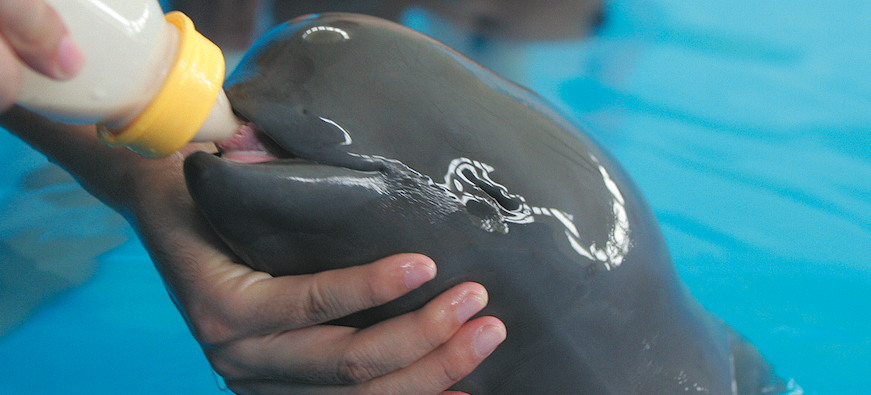


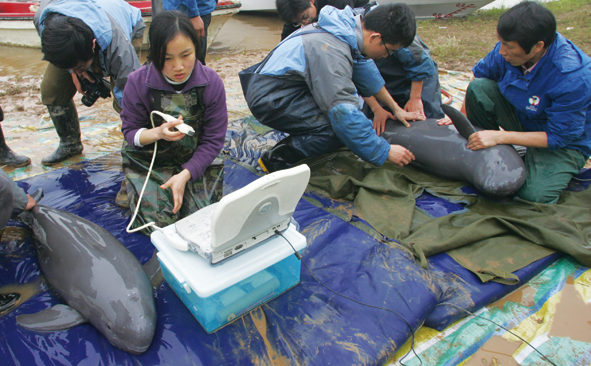
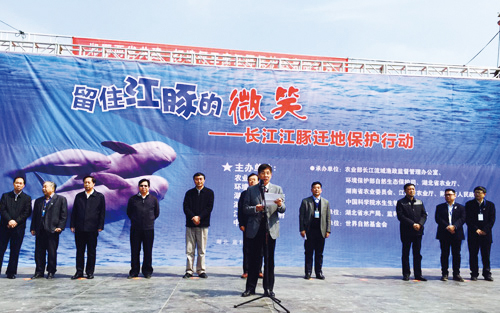
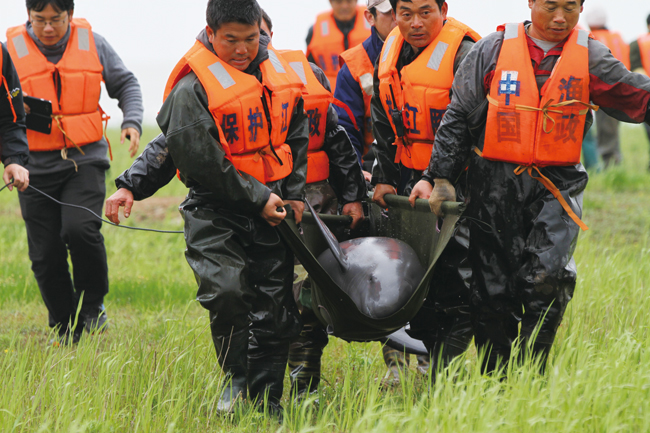
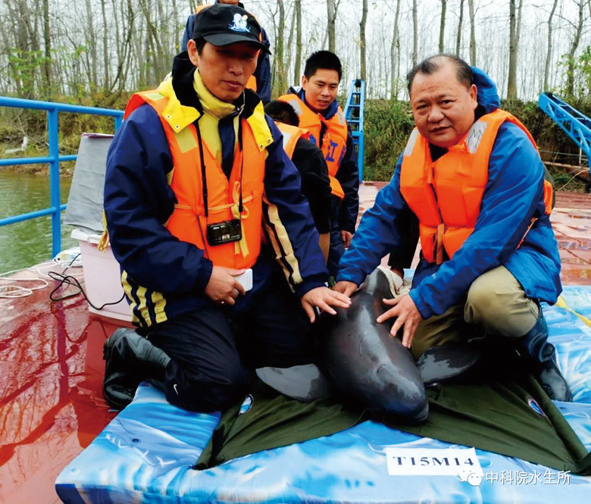
By MEI Zhigang**
Institute of Hydrobiology, Chinese Academy of Sciences, Wuhan, China

Feeding a Yangtze finless porpoise calf at the aquarium established for research and conservation of the cetacean located at the Institute of Hydrobiology, Chinese Academy of Sciences. (Photo by WANG Xiaoqiang)
Noting that the fundamental requirement for the conservation of biological diversity is the in situ conservation of ecosystems and natural habitats and the maintenance and recovery of viable populations of species in their natural surroundings; and noting further that ex situ measures preferably in the country of origin, also have an important role to play. Here “ex situ conservation (i.e., conservation by relocation)” refers to the relocation of biodiversity components outside their natural environments for conservation. Each Party shall, to the extent possible and as appropriate, primarily to complement in situ conservation: take measures to relocate the biodiversity components for ex situ conservation, preferably in their countries of origin; establish and maintain facilities for ex situ conservation and research of plants, animals and micro-organisms, preferably in the countries of origin of the genetic resources; take measures to restore and rehabilitate endangered species and, where appropriate, reintroduce these species into their natural habitats; control and manage the collection of biological resources in natural habitats for ex situ conservation purposes in a manner that does not threaten ecosystems and native species communities ...
– Extracted and adapted from the Convention on Biological Diversity (UN, 1992)
“Information from the current ex situ conservation efforts for the critically endangered Yangtze finless porpoise indicates that populations within three managed reserves are successfully reproducing. One of these reserves had sufficient individuals to transport some to a new ex situ area ...... notes that the program for translocating finless porpoise appears to be effective, and commends the Chinese Government, Wang Ding and his colleagues for the progress they have made in this regard.”
This is a quote from the 2017 annual report released by the Scientific Committee of the International Whaling Commission. Compared to the plight faced by other critically endangered small cetacean populations around the world that continue to decline and are struggling on the verge of extinction, this progress gives a very positive message, signaling the initial success of the natural ex situ protection of the Yangtze finless porpoise in China, which has resulted in rapid and effective preservation of the species and has provided a “safety rope” for its long-term conservation. The theory and technological system of ex situ conservation developed and established by the Chinese research and conservation team has brought confidence and hope for the conservation and protection of small threatened and endangered cetaceans worldwide as the “Chinese experience”.
All this is not an easy story, however. Instead, it has been a hard-won victory resulting from a long struggle of over 30 years, with many twists and turns.
Back in 1986, a group of Chinese scientists, represented by Prof. CHEN Peixun at the Institute of Hydrobiology (IHB) under the Chinese Academy of Sciences, proposed integrating in situ conservation, ex situ conservation, and captive breeding in conservation practice to save the Chinese river dolphin. For the very first time, ex situ conservation was proposed as a solution in the field of cetacean conservation. However, the international academia and conservation organizations objected to this suggestion. Their main argument was that it would be contrary to the animals’ welfare should we put animals as intelligent as cetaceans in artificial spaces; hence the only way out should be strengthened in situ conservation, rather than ex situ conservation. Unfortunately, at a time of rapid economic development, in situ conservation was never easy – and it remains hard till today.

Left and right: Group photos from The First International Symposium on Conservation of River Dolphins (Photos by courtesy of IHB)
But the Chinese river dolphin cannot wait. It had already become critically endangered, and immediate actions were needed to preserve the species. After carefully weighing the pros and cons, the research team led by Prof. WANG Ding worked from scratch to explore theories and practices for ex situ conservation, and chose the Tianezhou Oxbow, which is part of the ancient Yangtze waterway and bears natural conditions similar to those of the nowadays Yangtze River, as an experiment site. Living in an environment similar to the Chinese river dolphin, the Yangtze finless porpoise still retained a considerably large population at that time, and hence was chosen as a substitute species for the Chinese river dolphin for the experiment. In 1990, five finless porpoises became the first “migrants”, and two years after the relocation they successfully bred offspring. To the team’s regret, the Chinese river dolphin population had already become too small to sustain, therefore the Tianezhou Oxbow failed to become the cetacean’s last refuge. At this critical time, the Yangtze finless porpoise, which was then also in a difficult situation struggling for survival, naturally became a new target for ex situ conservation.
At the time, some difficulties were still pending for solution. For example, to scientifically manage the ex situ population of the Yangtze finless porpoise in the oxbow, long-term monitoring on the species is a precondition; however, the Yangtze finless porpoise is timid, and it is smaller in size and moves much faster than large cetaceans – all these made it necessary to develop new methods and techniques to track and monitor its behavior, as the existing techniques, previously developed for large cetaceans, were not applicable to them. After repeated attempts, Chinese and Japanese scientists jointly developed a set of acoustics-based technology for this sake. This was far from enough. To accurately assess the number of the individuals and their health, the most direct and effective way would be to catch and sample them in their natural habitat; however, this would in return expose the endangered species to greatly worsen risks. With years’ efforts, the Chinese conservation team gradually developed a set of methods to solve the problem. The method applies acoustic techniques to repel the individuals into certain locations, and then catch them with fishing nets via step-wise measures, and quickly release the captured animals after the measuring operation. The newly developed methods greatly reduced the damages to the captured animals. With careful management, by 2008, the Yangtze finless porpoise population in the Tianezhou Oxbow gradually grew to include 40 individuals.

Prof. WANG Ding, leader of the IHB team, experiments with an acoustic marker to track and monitor the porpoise at the Tianezhou Oxbow. (Photo by WANG Xiaoqiang)
However, the population was soon stricken hard by the severe ice storm that befell southern China in early spring 2008, and was only barely saved by timely rescue. This setback gave a wake-up call that we shall not put all eggs in one basket. In fact, establishing multiple ex situ reserves is a must to save the endangered Yangtze finless porpoise, even if the potential damages from inadvertent natural disasters did not count. Under the leadership of the former Ministry of Agriculture, the research team set up an ex situ reserve in the Hewangmiao Oxbow in Jianli, Hubei province (co-managed by Huarong, Hunan province) in 2015, and another in the Xijiang Oxbow in Anqing, Anhui province later in 2016. The Yangtze finless porpoise individuals introduced to the two reserves reproduced naturally the following year and have continuously thrived ever since. Through natural reproduction and further introduction of individuals from the wild, both populations have seen rapid development with more than 20 individuals. With the rapid growth of the Yangtze finless porpoise ex situ populations, international skepticism has gradually diminished.

The team comes for rescue of the porpoises stricken by the severe ice storm in 2008. (Photo by WANG Xiaoqiang)
While increasing the population quantity, improving the quality became more critical. As the relocated populations are still relatively small and isolated from each other, the individuals cannot mate with those in natural habitats; this, if continued on, would inevitably lead to inbreeding and hence poor-quality offspring in the long run. To solve this problem, we developed a set of mature technology for paternity test. Based on the analysis, we introduced eight porpoises from the wild to the Tianezhou Oxbow in 2013, 2014, 2016 and 2017 via rescue and individual exchanges, and successfully improved the genetic diversity. More importantly, as a result, the individuals in the two newly established translocated populations were all mixed with different genetic backgrounds. Based on this work, we are currently implementing the “Genetic Management Project of Ex situ Yangtze Finless Porpoise Populations” under the guidance of the Chinese Ministry of Agriculture and Rural Affairs.
In addition to establishing natural ex situ populations, we also prepared a Plan B, which focused on captive breeding research based at the Chinese river dolphin aquarium of IHB. Since 1996, we have accumulated a lot of data about the behavior and physiology of the Yangtze finless porpoise; starting from this we established a set of technology for captive breeding. In 2005, the first Yangtze finless porpoise artificially bred in captivity was born. This porpoise calf grew healthily, and bred offspring subsequently. In fact, the aquarium has witnessed multiple cases of successful artificial reproduction. The success has been duplicated in the net cages of the Tianezhou Oxbow since 2008. Currently, the ex situ population in Tianezhou has grown to include over 100 animals, and 18 selected individuals were exported to other ex situ sites in 2021. Together with the relocated individuals in the Hewangmiao Oxbow, Xijiang Oxbow, Chinese river dolphin aquarium, the overall “conserved” population of Yangtze finless porpoise has reached more than 150 individuals and is continuously increasing.
So far, the story was just half told, however. The ex situ reserves are by no means the goal of the preservation. The ultimate destination of the relocated populations shall be the animals’ home habitat – the Yangtze River where they can surf freely. We felt obligated to lay out a road map for the rehabilitation of the animals as well as their reintroduction to their native habitat, albeit it was challenging to achieve this goal given the limited time and technology available, against the background that the degraded eco-environment of the Yangtze catchment saw little improvement in general. In 2011, we reintroduced a male individual of Yangtze finless porpoise, dubbed “A Bao”, back to the Tianezhou Oxbow reserve. First migrated in 2004 from the Tianezhou Oxbow, by then it had been kept in captivity at the Chinese river dolphin aquarium at IHB for seven years. We first kept it in the net cages and the purse seines for rehabilitation training, aiming to reconstruct its feeding habits, reshape its preying and swarming behaviors, and so as to re-adapt it to the natural environment. After four months’ rehabilitation, the individual was released back to the natural waters of the Tianezhou Oxbow. In 2015, the individual was recaptured for examination. It was found to be healthy, and more importantly, he had at least two children since reentering the wild. More remarkably, before he left the oxbow in 2004, he had three children; and now the three children had already produced at least 10 grand-children and at least two great-grandchildren.
This case demonstrates that after scientific training for rehabilitation, the Yangtze finless porpoise can entirely re-adapt to natural environments again; and this provides strong theoretical support for the feralization and reintroduction of the species back to nature. In 2013, we worked with the National Nature Reserve for Chinese River Dolphin located in the Yangtze River in Xinluo section, Hubei province to conduct a feasibility study for a wildlife release base in Laowan passage of ancient Honghu Lake catchment, and the feasibility report got approved by the former Ministry of Agriculture. In 2017, we assisted the Reserve in completing a solution for environmental optimization of the site. And in 2021, with the completion of various environmental improvements and facility building, it received two Yangtze finless porpoise reintroduced from Tianezhou. They are now receiving adaptive training, and this marks the first attempt to reintroduce from an ex situ habitat to an in situ one.

Launching of the ex situ conservation project at the Hewangmiao Oxbow in 2015. (Photo by GAO Baoyan)
A scientific survey conducted in 2017 for the ecological environment of the Yangtze finless porpoise showed that compared to 2012, the previously rapid decline in population had been curbed; in some waters of the catchment, such as those in the Dongting Lake basin and the Nanjing area of the Yangtze River catchment, the population of the Yangtze finless porpoise was even recovering, which indicated that the conservation actions of the finless porpoise as a collective effort by the government as well as non-governmental sectors in China had achieved some results.
Further, in January 2018, the State imposed a strict and comprehensive fishing ban in all aquatic reserves of the Yangtze River basin.

In 2015, A Bao, the male porpoise reintroduced back to the natural waters of the Tianezhou Oxbow experimental site in 2011, was recaptured for a physical examination. It was found to be healthy, having at least two children since the reintroduction. (Photo by GAO Baoyan)
From January 2020 to the end of the same year, fishermen were to retreat from fishing in the Yangtze River main stream and important tributaries, starting with a tentative fishing ban of 10 years. The provinces along the Yangtze River also enhanced the improvement and restoration of the Yangtze River shoreline and strictly controlled the sewage discharge. As a result, the once severe extractions of sand resources in the Dongting Lake and Poyang Lake basins were fundamentally controlled. As powerful actions to implement the “Grand Protection of Yangtze River”, these measures laid a most important stepping stone for the conservation of aquatic wildlife, and would definitely produce a positive impact on the conservation of the Yangtze finless porpoise.
In 2019, the International Union for Conservation of Nature and other organizations held an international symposium on the conservation progress and insights of the Yangtze finless porpoise in Wuhan. The meeting highly recognized the ex situ conservation of the Yangtze finless porpoise and suggested that the involved technology should be applied to the conservation of other rare and endangered small cetaceans in the world, such as the Vaquita.

Joyful reunion at the Tianezhou Oxbow: In 2015, Prof. WANG Ding, leader of the IHB team, reunites with A Bao, the porpoise released back to the natural waters of the oxbow and recaptured for physical tests. (Photo by WANG Xiaoqiang)
In retrospect, in addition to China’s own unremitting efforts, the conservation of the Yangtze finless porpoise has received strong support from the international community. Out of the international morality of nature conservation, and given that we have accumulated beneficial experiences in the Yangtze finless porpoise conservation, it is time for us to make our contributions to the international efforts for aquatic wildlife conservation, in any means we can.
(Translated by SONG Jianlan)
Notes:
* This is an authorized translation from an article published in Issue 4, 2020 of the Man and the Biosphere, abbreviated as MAB, a Chinese-language magazine aimed at
improving our relationship with nature and raising public awareness for this. BCAS thanks the magazine and the author for their kind permission to republish both the text and the
images involved.
** About the author: Dr. MEI Zhigang is a researcher at the Institute of Hydrobiology, Chinese Academy of Sciences who has been dedicated to the research and conservation of river dolphins.
Reference
United Nations, 1992. Convention on Biological Diversity.

